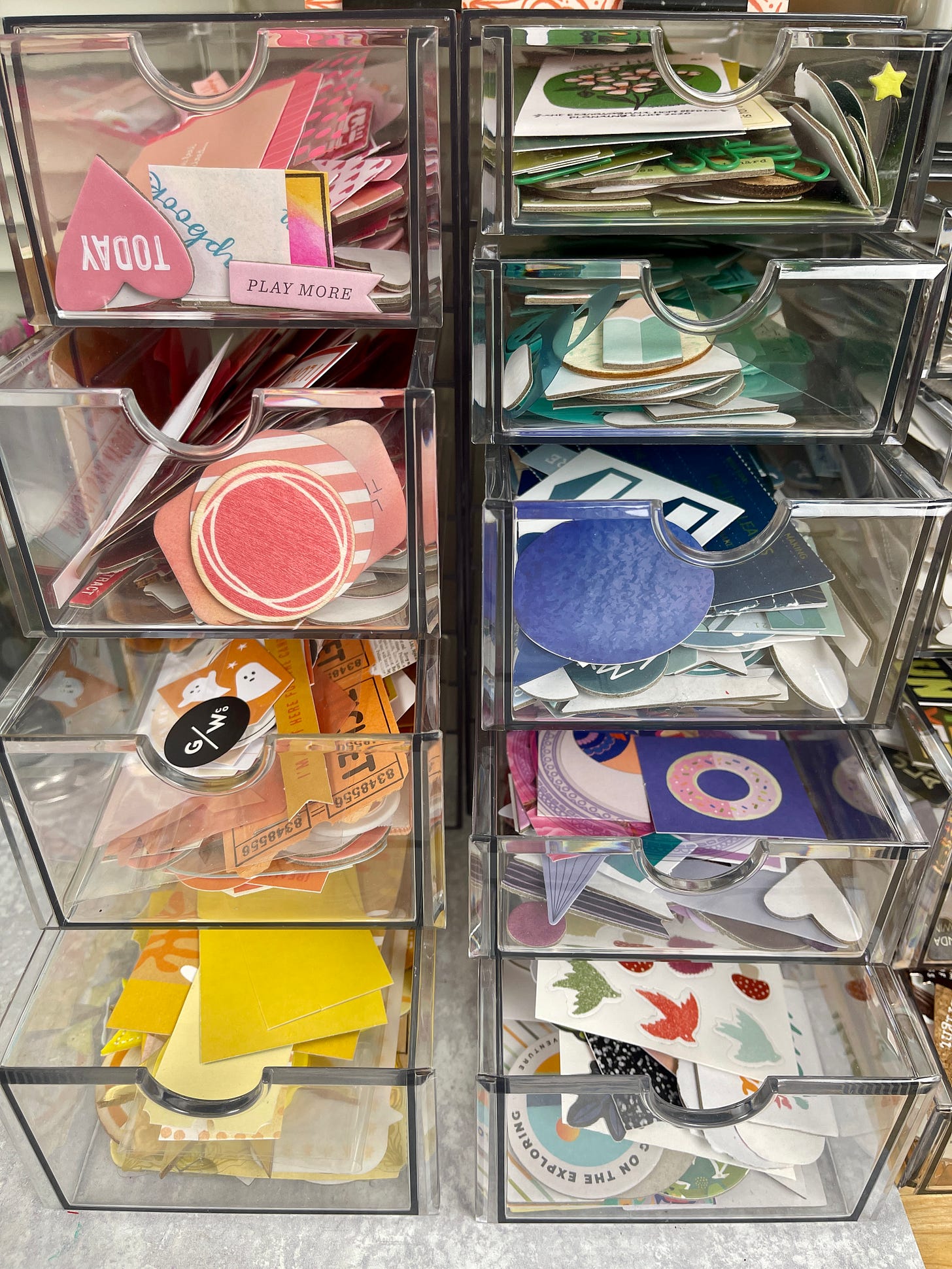How I Create a Supply Stash That Works for Me
Getting the most out of what you've already got
Over the past several years, through my Daily Pages, and other projects, I've developed creative habits that keep me grounded, excited, and constantly inspired. One of the most important pieces of that puzzle is building a supply stash that works for me. It’s not about hoarding every pretty thing (though I’ve been there); it’s about having what you need, when you need it, in a way that makes finding it, and using it feel effortless.
Here’s how I do it—and how you can too. Try out these techniques and see which ones work for you and the way that you like to create.
1. Curate Your Essentials Box
Start with a box filled with the stuff you can’t live without—the tools and supplies you reach for every single time. Think of it as your creativity safety net.
Here’s what’s in mine:
Black ink and a stamp block
My go-to adhesives: a tape runner and glue stick
A couple of black pens and one or two colored markers
and whatever else I’m in love with at the moment
Here’s a post from about ten years ago, where I talk about the exact same thing. It’s one of the longest-running stash things that has worked for me and the way I create.
This box is all about ease and simplicity. On days when time (or motivation) is short, I grab it and dive in—no overthinking required. Having only your tried-and-true supplies makes creating feel natural and effortless.
2. Organize by Creative Vibe, Not Categories
Traditional organization—like putting all my journaling cards together—doesn’t always work for me. Instead, I group some of my supplies by how I like to create.
Here’s a few ways I sort mine:
Mood Boosters: Bright, playful supplies for when I’m feeling bold and energetic and really want to dive into something fun (great for days you're feeling confident).
Low-Effort Stash: Pre-cut embellishments, journaling cards, seasonal stickers, and pre-made papers for days when I want to keep things simple.
Exploration Zone: Tools and techniques I haven’t tried yet, or a stack of new supplies—perfect for experimenting in my Daily Pages.
This system means I don’t have to dig for the “right” thing. It’s all about leaning into how I’m feeling that day and letting my stash support me.
3. Pre-Make Backgrounds or Base Layers
Small bursts of creative energy can go a long way when you use them to prep ahead. During a Daily Pages session or a quiet afternoon, I love whipping up backgrounds or base layers to use later.
A few favorites to create:
Gel print backgrounds on paper or cardstock
Simple collage pages using scraps from my desk
Repeating stamped patterns for a unique touch
I keep these in an expanding file folder near my workspace (though I’m overdue for an upgrade). Having a stash of pre-made elements is like meal prepping for your creative projects—but way more fun.
4. Organize Small Bits by Color in Clear Boxes
This method has been a game-changer for me, especially this past year. Since color inspires so much of my creative process, organizing small bits by hue makes everything quicker and more satisfying.
Here’s my system:
Each color gets its own clear container.
Tiny items are tucked into mini pockets or envelopes within the boxes.
A “multi-color” box holds anything that doesn’t fit into a single category.
Being able to see everything at a glance is a huge help. Sometimes, I even grab a single box and let the color palette decide where my project goes. It’s like instant inspiration.
5. Store Scraps in Ready-to-Use Form
Scrap paper can be overwhelming if it’s just a pile of random shapes. For me, even just looking at a big box of different scraps can make me never want to touch it. To make scraps a worthwhile part of my creative process, I trim them down a bit and store them with like-sizes.
Here’s what I keep prepped:
Daily Pages-sized backgrounds
Tags or small rectangles
Strips for borders or layering (perfect for strip pages)
I organize these in bins at the top of my Raskog carts. It’s easy to grab a bin, bring it to my desk, and flip through for the perfect piece—no digging or trimming mid-project required.
A Stash That Works for You
Your supply stash should feel intuitive and make creating easier, not harder. By curating an essentials box, organizing by vibe, or trimming scraps into usable pieces, you’re setting yourself up for success.
The goal? Find joy in what you already have and tweak your system to work for you.
Happy creating! Do any of these ideas resonate? Let me know—I’d love to hear how your stash is working for you.








